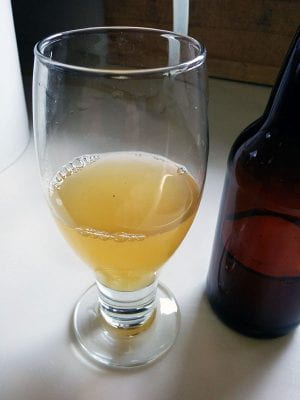Brewed for FoodBev 102 “Taste: The Culture & Science of Fermentation” (February 9, 2017)
Source
Rösch, Manfred. Pflanzenreste aus Tumulus 17 Grab 1. Bettina Arnold and Matthew L. Murray, with contributions by Tanja Kreß. A Landscape of Ancestors: Archaeological Investigations of Two Iron Age Burial Mounds in the Hohmichele Group, Baden-Württemberg. LAD Baden-Württemberg: Forschungen und Berichte zur Vor- und Frühgeschichte in Baden-Württemberg. Stuttgart: Konrad Theiss Verlag.
Batch Size: 5 gal.
Mash Temp: 150F
Initial gravity: 1.050
Final gravity: 1.006
Estimated ABV: 5.78%
Grain Bill
Rahr Pale 2-row, 2.5 lbs
Warminster Floor Malted Maris Otter, 1 lbs.
Weyerman Smoked Malt, 1.5 lbs.
Wildflower Honey, 4 lbs.
Other
Meadow sweet (Filipendula ulmaria), dried flowers and stalks, 2.0 oz.
Mint (Mentha sp.), dried, 1.5 oz.
Yeast: Wyeast Lambic Yeast 3278 package
Procedure
Pour the grains into a mesh bag and lower it into the mash tun where the hot water should be at about 145˚F. Raise the temperature to about 150˚F and hold for a mash time of about an hour. After 30 minutes, add the first 3 lbs. of honey to the boil. Next, place the meadow sweet and mint in a mesh bag with a knot tied into the top and drop into the wort. Add the remaining 1 lbs. of honey and steep for another 15 minutes. Pour 5 gallons of wort into a carboy; cool. Pitch one package of Lambic yeast at 80F. Let ferment at 70F. Allow to ferment until yeast is no longer active; then either bottle (we bottled on March 18, 2017) or transfer to a barrel system for aging. Best if aged at least 6 weeks and should cellar well.
Results
 This version differed from the Keltenbräu 2.0 Lakefront braggot in that about 10 students sampled the wort while it was boiling and before it was added to the fermentation bucket, which resulted in proportionally more honey to wort. We also doubled the amount of meadowsweet and added about half again as much mint, which was dry rather than fresh this time. The yeast used was Lambic rather than California Ale yeast, which still seems to have resulted in a bottled product with very little sugar remaining but with a light honey scent. Also, we used a standard plastic bucket home brewing system as compared to the much more high tech Lakefront set up. The result at bottling was a cloudy straw-colored brew that had a slight mint flavor upfront with a bit of astringency from the meadowsweet and a honey finish. It should clarify as it settles in the bottle and the eventual ABV may be higher than that calculated at bottling. At 5.78 ABV this version of the braggot is definitely less alcoholic than the Lakefront batch.
This version differed from the Keltenbräu 2.0 Lakefront braggot in that about 10 students sampled the wort while it was boiling and before it was added to the fermentation bucket, which resulted in proportionally more honey to wort. We also doubled the amount of meadowsweet and added about half again as much mint, which was dry rather than fresh this time. The yeast used was Lambic rather than California Ale yeast, which still seems to have resulted in a bottled product with very little sugar remaining but with a light honey scent. Also, we used a standard plastic bucket home brewing system as compared to the much more high tech Lakefront set up. The result at bottling was a cloudy straw-colored brew that had a slight mint flavor upfront with a bit of astringency from the meadowsweet and a honey finish. It should clarify as it settles in the bottle and the eventual ABV may be higher than that calculated at bottling. At 5.78 ABV this version of the braggot is definitely less alcoholic than the Lakefront batch.